 One of the highlights of my visits to Rome is the opportunity to see old friends like Daniele Cernilli (Doctor Wine) and Marina Thompson, his wife. This year, they invited Michele and I to their home for a light supper with some special wines.
One of the highlights of my visits to Rome is the opportunity to see old friends like Daniele Cernilli (Doctor Wine) and Marina Thompson, his wife. This year, they invited Michele and I to their home for a light supper with some special wines.
 Daniele is one of the world’s foremost experts on Italian wine and is the author of The Essential Guide to Italian Wine which is updated annually. Pictured above is the 10th edition, published for 2024. The book is my go-to reference book for Italian wines since, as Daniele said, “All the wines worth drinking are in the pages of this guide.” Both Italian and English versions of the book are available.
Daniele is one of the world’s foremost experts on Italian wine and is the author of The Essential Guide to Italian Wine which is updated annually. Pictured above is the 10th edition, published for 2024. The book is my go-to reference book for Italian wines since, as Daniele said, “All the wines worth drinking are in the pages of this guide.” Both Italian and English versions of the book are available.
 GT Ravenna Bianco 2011 “Tergeno” Fattoria Zerbina made from 6% Albano late harvest, 34% Albano secco, and 50% Chardonnay from different vineyards with different training systems and different quantities of vines per hectare. Part of the Albano is fermented in barriques while the remainder ferments in stainless steel. The wine was aged for 12 months in stainless steel and barriques and then 6 months in bottle before release.
GT Ravenna Bianco 2011 “Tergeno” Fattoria Zerbina made from 6% Albano late harvest, 34% Albano secco, and 50% Chardonnay from different vineyards with different training systems and different quantities of vines per hectare. Part of the Albano is fermented in barriques while the remainder ferments in stainless steel. The wine was aged for 12 months in stainless steel and barriques and then 6 months in bottle before release.
The wine was not showing any signs of age. It was rich and opulent with hints of citrus and tropical fruits. Daniele picked this vintage to go with our foie gras appetizer, a perfect match.
The style of this wine has been changed over the years. Since 2014, it is a completely different wine and even the label is different from the bottle we tasted.
Tergeno was introduced in 1991 as a blend of three wines: Chardonnay, Sauvignon Blanc and Gewürztraminer. After five years as a dry wine they found the results achieved with the Albano grape affected by noble rot was very good. So they decided to produce a version in the late harvest style, using a selection of Albano harvested late with botrytis combined with a part of Chardonnay and vinified as a dry white.
Thanks to botrytis, the wine acquires a very distinct and unique personality. Starting from the 2014 harvest this wine is 100% Albano, with 30% late harvested. Today the fermentation is in stainless steel and the wine is aged in stainless steel and 6 months in bottle before release.
.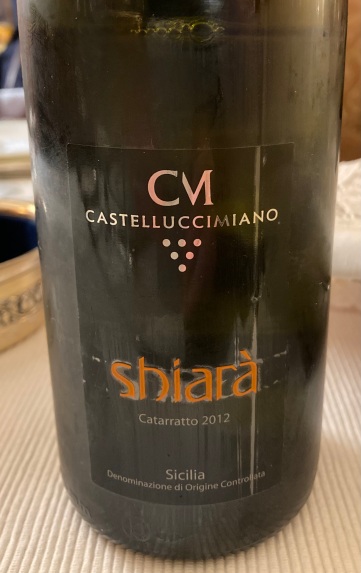 Castellucci Miano DOC Valledolmo-Contea di Sclafani-Sicily “Shiara” Bianco 2012 made of 100% Catarratto from 30/40 years old vines located on the slopes of the Madonie Montains at 700/900 meters. Training system is alberello and sapling, the pruning is guyot and spur. Soil is half sand and clay with an alkaline reaction due to active limestone. Harvest takes place in October. White wine vinification with fermentation at a controlled temperature. Malolactic fermentation does not take place. The wine remains in stainless steel for 6 months and then in bottle for 4 months before release. The wine has hints a citrus fruit, apple, and pear with a touch of cantaloupe and crisp acidity $35. Catarratto is a grape indigenous to Sicily. I tasted the 2019 last year with the US importer, Tony Margiotta of Gladiator wines. As Daniele said, this is a white wine that can age.
Castellucci Miano DOC Valledolmo-Contea di Sclafani-Sicily “Shiara” Bianco 2012 made of 100% Catarratto from 30/40 years old vines located on the slopes of the Madonie Montains at 700/900 meters. Training system is alberello and sapling, the pruning is guyot and spur. Soil is half sand and clay with an alkaline reaction due to active limestone. Harvest takes place in October. White wine vinification with fermentation at a controlled temperature. Malolactic fermentation does not take place. The wine remains in stainless steel for 6 months and then in bottle for 4 months before release. The wine has hints a citrus fruit, apple, and pear with a touch of cantaloupe and crisp acidity $35. Catarratto is a grape indigenous to Sicily. I tasted the 2019 last year with the US importer, Tony Margiotta of Gladiator wines. As Daniele said, this is a white wine that can age.
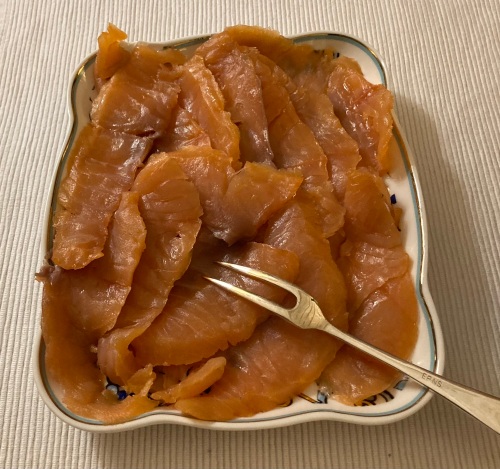 Smoked salmon served with toast points and French butter
Smoked salmon served with toast points and French butter
 Roasted Marinated Yellow Peppers
Roasted Marinated Yellow Peppers
 Barbaresco DOCG 2016 ‘Manzola” Nada Fiorenzo made from Nebbiolo (Lampia and Michet) from Manzola in the commune of Treiso in Piedmont. The vines were planted in 1998 and the soil is calcareous-clayey with sandy outcrops. Exposure is southwest at 230 meters. Manual harvest followed by a soft pressing of the grapes and separate vinification for each single parcel. There are no herbicides and other invasive vine protection products used and a return to old practices such as hand-hoeing. Aging is in oak for 24 months and in bottle for 6 months before release. The wine has hints of cherry, licorice, leather, tea and a hint of spice. It is a wine that can age.
Barbaresco DOCG 2016 ‘Manzola” Nada Fiorenzo made from Nebbiolo (Lampia and Michet) from Manzola in the commune of Treiso in Piedmont. The vines were planted in 1998 and the soil is calcareous-clayey with sandy outcrops. Exposure is southwest at 230 meters. Manual harvest followed by a soft pressing of the grapes and separate vinification for each single parcel. There are no herbicides and other invasive vine protection products used and a return to old practices such as hand-hoeing. Aging is in oak for 24 months and in bottle for 6 months before release. The wine has hints of cherry, licorice, leather, tea and a hint of spice. It is a wine that can age.
 Baked eggplant with tomato and mozzarella was our main course.
Baked eggplant with tomato and mozzarella was our main course.
 Vinsanto del Chianti Classico 2013 Fontodi in half bottle made from Malvasia and Sangiovese from various vineyards within the property. There are 3,500 to 6,000 vines per hectare and the training system is guyot. The grapes are naturally dried for 5 months after harvest. After the pressing, the must is racked into chestnut and oak barrels of 50 and 110 liters where aging takes place for at least 6 years. There are only 3,000 bottles produced. Fontodi is located in Panzano in Chianti. This is an excellent dessert wine with hints of hazelnut, dried apricot, honey and a touch of caramel.
Vinsanto del Chianti Classico 2013 Fontodi in half bottle made from Malvasia and Sangiovese from various vineyards within the property. There are 3,500 to 6,000 vines per hectare and the training system is guyot. The grapes are naturally dried for 5 months after harvest. After the pressing, the must is racked into chestnut and oak barrels of 50 and 110 liters where aging takes place for at least 6 years. There are only 3,000 bottles produced. Fontodi is located in Panzano in Chianti. This is an excellent dessert wine with hints of hazelnut, dried apricot, honey and a touch of caramel.
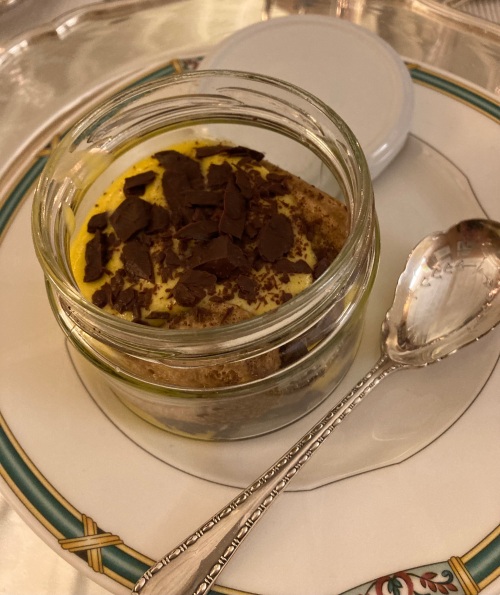 Tiramisu — A classic version that Daniele highly recommended
Tiramisu — A classic version that Daniele highly recommended
I always enjoy seeing Daniele and Marina and I always learn something new.



 Bocale (Umbria) Montefalco Sagrantino 2016 made from 100% Sagrantino. The vineyard is treated with natural grass regeneration techniques (land planting), using only organic and mineral fertilizers without the use of chemical products or herbicides. Fermentation is with natural yeasts and the wine is produced without microfiltration and thermal stabilization. Manual harvest takes place the second half of October. Vinification: maceration for at least 40 days with natural enzymes. Stabilization and filtration do not take place. The wine is aged in 1,000 liter French oak barrels for 24 months and in bottle for 12 months before release. The wine has hints of blackberries and currants with a touch of spice. I was very impressed with this wine. This wine will age and Daniele said Sagrantino has the highest polyphenols and tannin of any grape. Above is a picture of the 2015 I have at home.
Bocale (Umbria) Montefalco Sagrantino 2016 made from 100% Sagrantino. The vineyard is treated with natural grass regeneration techniques (land planting), using only organic and mineral fertilizers without the use of chemical products or herbicides. Fermentation is with natural yeasts and the wine is produced without microfiltration and thermal stabilization. Manual harvest takes place the second half of October. Vinification: maceration for at least 40 days with natural enzymes. Stabilization and filtration do not take place. The wine is aged in 1,000 liter French oak barrels for 24 months and in bottle for 12 months before release. The wine has hints of blackberries and currants with a touch of spice. I was very impressed with this wine. This wine will age and Daniele said Sagrantino has the highest polyphenols and tannin of any grape. Above is a picture of the 2015 I have at home. There were 10 wines: 3 whites, 6 reds and a Moscato d’Asti.
There were 10 wines: 3 whites, 6 reds and a Moscato d’Asti.  The wines to be tasted
The wines to be tasted  Moscato d’Asti DOCG NV made from 100% Moscato di Canelli (Piedmont ) Luca Bosio. The vineyards are at 200/300 meters and the training system is guyot. Soil composition is clayey calcareous. Vinification takes place without the skins for 5 days in steel tanks at low temperature (15 C) The wine ages for 2 months on its own yeast. Total residual sugar is 130g/l. The wine has hints of citrus fruit, apricot, pineapple, peach and honeysuckle. $18
Moscato d’Asti DOCG NV made from 100% Moscato di Canelli (Piedmont ) Luca Bosio. The vineyards are at 200/300 meters and the training system is guyot. Soil composition is clayey calcareous. Vinification takes place without the skins for 5 days in steel tanks at low temperature (15 C) The wine ages for 2 months on its own yeast. Total residual sugar is 130g/l. The wine has hints of citrus fruit, apricot, pineapple, peach and honeysuckle. $18 I always look forward to discussing wine with Daniele while enjoying a delicious meal.
I always look forward to discussing wine with Daniele while enjoying a delicious meal. This time, Daniele brought me a copy of his book The Essential Guide to Italian Wine 2022. It will be my go-to reference book for Italian wines since, as Daniele said, “All the wines worth drinking are in the pages of this guide.”
This time, Daniele brought me a copy of his book The Essential Guide to Italian Wine 2022. It will be my go-to reference book for Italian wines since, as Daniele said, “All the wines worth drinking are in the pages of this guide.” Daniele also brought me a copy of his new travel guide book, Mangiare e Dormire tra i Vigneti, Eating and Sleeping in the Vineyards, which should be essential for anyone traveling Italy’s wine roads. This is one in a series of books on travel and wine.
Daniele also brought me a copy of his new travel guide book, Mangiare e Dormire tra i Vigneti, Eating and Sleeping in the Vineyards, which should be essential for anyone traveling Italy’s wine roads. This is one in a series of books on travel and wine. 
 Little choux pastry puffs filled with ricotta, tomatoes and basil
Little choux pastry puffs filled with ricotta, tomatoes and basil Animelle–sweetbreads with wild chicory and brie cheese sauce
Animelle–sweetbreads with wild chicory and brie cheese sauce Sauteed Lamb Offal (Coratella) & Roman artichoke
Sauteed Lamb Offal (Coratella) & Roman artichoke “Coda in Carrozza”– fried sandwiches with braised oxtail
“Coda in Carrozza”– fried sandwiches with braised oxtail “Porchetta” pork roast wraps with marinated cherry tomatoes and yogurt sauce
“Porchetta” pork roast wraps with marinated cherry tomatoes and yogurt sauce Spaghettone carbonara — the classic Roman pasta
Spaghettone carbonara — the classic Roman pasta Falanghina 2018 Campi Flegrei
Falanghina 2018 Campi Flegrei Cheese – We finished the wines with a variety of cheese, chestnut honey and fig jam.
Cheese – We finished the wines with a variety of cheese, chestnut honey and fig jam. Fiorano Vino Rosso 2013 Alessandrojacopo Boncompagni Ludovisi. Made from 65% Cabernet Sauvignon and 35% Merlot. The vineyard is at 130 meters and the soil is of volcanic origin. Exposure is north west-south west. There are 3,700 vines per hectare. The training system is espalier, spurred cordon pruning and the vines are 19 years old. Harvest is the third week of September.
Fiorano Vino Rosso 2013 Alessandrojacopo Boncompagni Ludovisi. Made from 65% Cabernet Sauvignon and 35% Merlot. The vineyard is at 130 meters and the soil is of volcanic origin. Exposure is north west-south west. There are 3,700 vines per hectare. The training system is espalier, spurred cordon pruning and the vines are 19 years old. Harvest is the third week of September.  Barolo 2010 “Sarmassa” Marchesi di Barolo made from 100% Nebbiolo. The vineyard exposure is south-east and the soil is clay and limestone with many stones. There are 4,000 vines per hectare and they are trained on a vertical trellised guyot system. Harvest is manual.
Barolo 2010 “Sarmassa” Marchesi di Barolo made from 100% Nebbiolo. The vineyard exposure is south-east and the soil is clay and limestone with many stones. There are 4,000 vines per hectare and they are trained on a vertical trellised guyot system. Harvest is manual. Dessert — Dark and white chocolate mousse
Dessert — Dark and white chocolate mousse Crostata of Ricotta and Visciole Cherry Jam
Crostata of Ricotta and Visciole Cherry Jam

 Salchetto “Nobile” 2018 made from 100% Prugnolo Gentile on 15 ha. Each plant makes one bottle. Manual harvest, sulfite free vinification with native yeasts takes place.
Salchetto “Nobile” 2018 made from 100% Prugnolo Gentile on 15 ha. Each plant makes one bottle. Manual harvest, sulfite free vinification with native yeasts takes place.


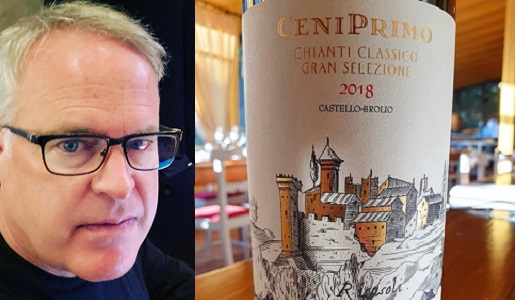
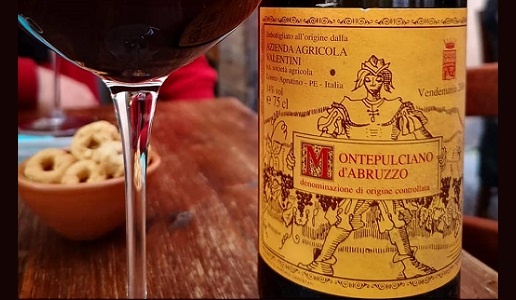
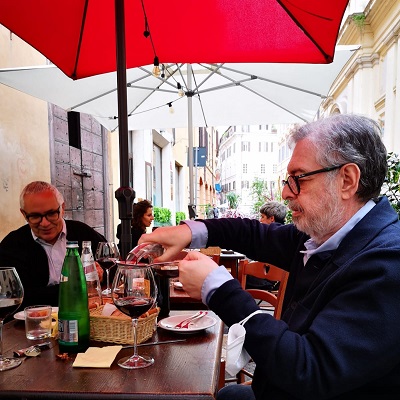 I
I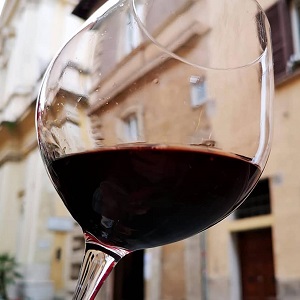 But it was through tasting the wine that we understood how it was on a different level than the other excellent wines we had sampled. The tannins were lively, distinct yet not aggressive. The right definition would be that they were “authentic”, grapey and with very little wood. Then there was that tad of carbonation, perhaps the product of the “remnants” of the initial malolactic fermentation in the bottle, which was so fine and composed it was hardly noticeable. This aspect may cause some rather orthodox tasters to turn up their noses but it had the same justification as Shakespearean poetic license had in obtaining the desired effect.
But it was through tasting the wine that we understood how it was on a different level than the other excellent wines we had sampled. The tannins were lively, distinct yet not aggressive. The right definition would be that they were “authentic”, grapey and with very little wood. Then there was that tad of carbonation, perhaps the product of the “remnants” of the initial malolactic fermentation in the bottle, which was so fine and composed it was hardly noticeable. This aspect may cause some rather orthodox tasters to turn up their noses but it had the same justification as Shakespearean poetic license had in obtaining the desired effect.

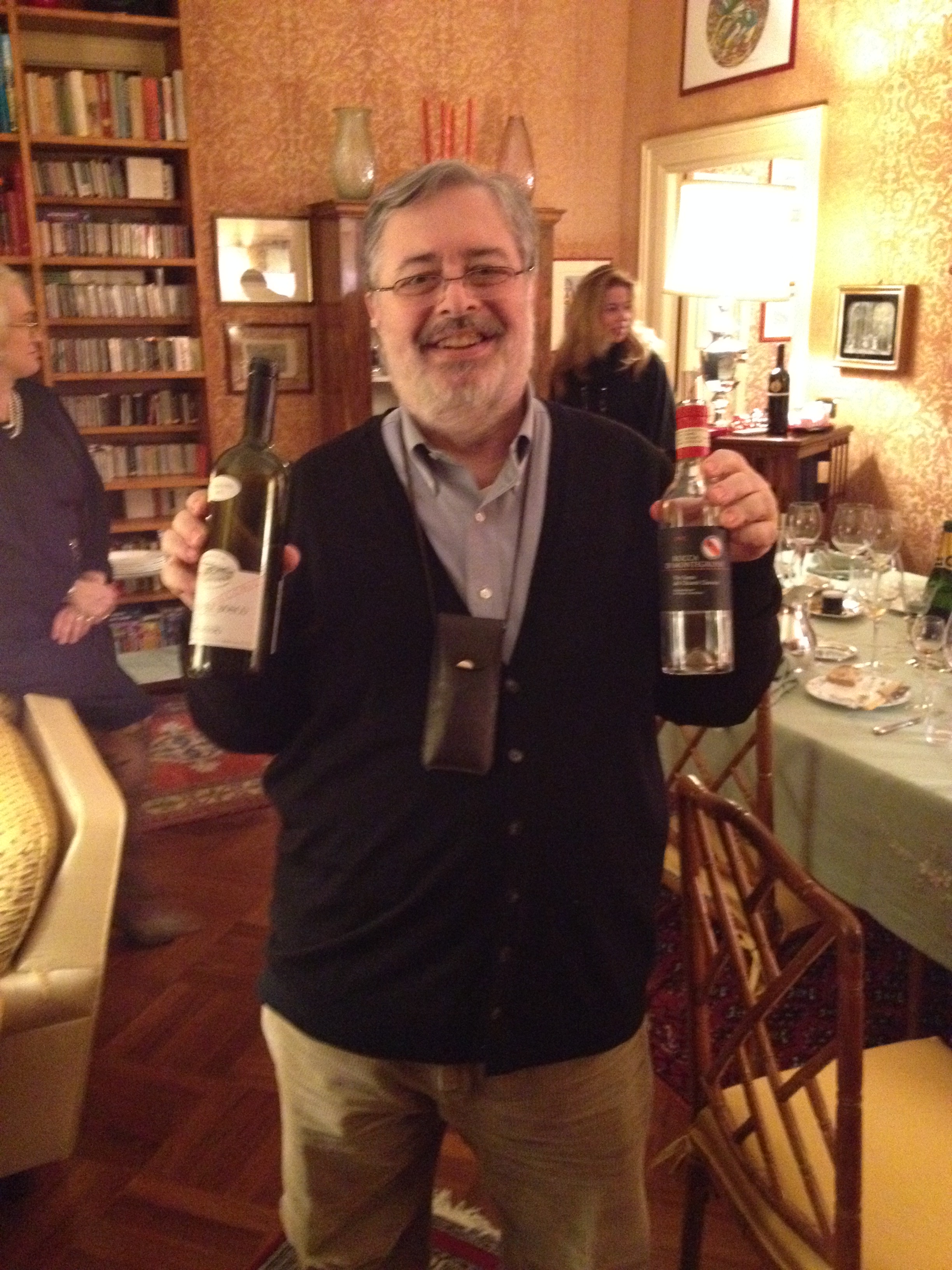
 Nine wines from different regions of Italy arrived so that participants could taste and discuss. The samples were sent in very small bottles with twist off caps.
Nine wines from different regions of Italy arrived so that participants could taste and discuss. The samples were sent in very small bottles with twist off caps.

 Albano Secco “ I Croppi” 2019 Celli made from 100% Albana. Production area Bertinoro. The soil is a clayey mixture with limestone and the exposure is east-south east. There are 3,000 to 500 plants per hectare and the training system is double guyot. Harvest was the first week of September. Fermentation is in stainless steel tanks as is the aging. The wine has hints of yellow peaches, apricots, a touch of citrus with salty and mineral notes. Imported by SolStars Inc.
Albano Secco “ I Croppi” 2019 Celli made from 100% Albana. Production area Bertinoro. The soil is a clayey mixture with limestone and the exposure is east-south east. There are 3,000 to 500 plants per hectare and the training system is double guyot. Harvest was the first week of September. Fermentation is in stainless steel tanks as is the aging. The wine has hints of yellow peaches, apricots, a touch of citrus with salty and mineral notes. Imported by SolStars Inc.
 Romagna Sangiovese Predappio 2018 Notturno Drei Dona – La Palazza made from 100% Sangiovese from the best grapes in their vineyards. There are 3,300 and 5,000 plants per hectare. Fermentation is in steel and concrete at a controlled temperature. The grapes are harvested, vinified and aged separately then assembled to complete the wine. The wine is aged for about one year is 15 and 25HL traditional casks and 500 liter tonneaux. The wine is bottled unfiltered. The wine has hints of dark red fruit, blackberries and blueberries, a touch of sweet spice and a note of caramel. Daniele said this estate is a point of reference not only for wine lovers but also for other producers. Imported by LNJ Brands, Inc
Romagna Sangiovese Predappio 2018 Notturno Drei Dona – La Palazza made from 100% Sangiovese from the best grapes in their vineyards. There are 3,300 and 5,000 plants per hectare. Fermentation is in steel and concrete at a controlled temperature. The grapes are harvested, vinified and aged separately then assembled to complete the wine. The wine is aged for about one year is 15 and 25HL traditional casks and 500 liter tonneaux. The wine is bottled unfiltered. The wine has hints of dark red fruit, blackberries and blueberries, a touch of sweet spice and a note of caramel. Daniele said this estate is a point of reference not only for wine lovers but also for other producers. Imported by LNJ Brands, Inc Sangiovese Superiore I Diavoli Le Rocche Malatestiane made from 100% sangiovese from vineyards between San Clemente and Gemmano in Rimini. The soil is tinted clay and chalk adjacent to the town of Gemmano at 250 meters. The wine is aged for six months in concrete tanks and one month is steel tanks. The production area for I Diavoli is close to the Natural Reserve of Onferno, called inferno (hell), because of the vapor rising from the crevasses and the bats, “the devils,” who lived in the underlining karst caves. The wine has hints of black cherry, blueberries, wildflowers and a touch of spice. It is part of the Cevico Group with 5,000 suppliers-partners that offers well-made wines at affordable prices. Imported by Terre Cevico
Sangiovese Superiore I Diavoli Le Rocche Malatestiane made from 100% sangiovese from vineyards between San Clemente and Gemmano in Rimini. The soil is tinted clay and chalk adjacent to the town of Gemmano at 250 meters. The wine is aged for six months in concrete tanks and one month is steel tanks. The production area for I Diavoli is close to the Natural Reserve of Onferno, called inferno (hell), because of the vapor rising from the crevasses and the bats, “the devils,” who lived in the underlining karst caves. The wine has hints of black cherry, blueberries, wildflowers and a touch of spice. It is part of the Cevico Group with 5,000 suppliers-partners that offers well-made wines at affordable prices. Imported by Terre Cevico Sangiovese Riserva Bertinoro 2014 Fattoria Paradiso made from 100% from the Vigna Delle Lepri Sangiovese Grosso. The wine is aged in cask for 18 months and 6 months in barriques followed by 12 months in bottle before release. I visited the winery a number of years ago and was impressed by this particular wine. The wine will be available in the US early this year. The wine has hints of blackberry, black cherry, licorice, dried roses and a touch of chocolate. Imported by Panebianco LLC
Sangiovese Riserva Bertinoro 2014 Fattoria Paradiso made from 100% from the Vigna Delle Lepri Sangiovese Grosso. The wine is aged in cask for 18 months and 6 months in barriques followed by 12 months in bottle before release. I visited the winery a number of years ago and was impressed by this particular wine. The wine will be available in the US early this year. The wine has hints of blackberry, black cherry, licorice, dried roses and a touch of chocolate. Imported by Panebianco LLC Romagna Sangiovese Predappio 2018 Noelia Ricci La Pandolfa 100% Sangiovese large berried type (Romagna biotype) from the Godenza vineyard in San Cristoforo in Foli. The vineyard is at 300 to 340 meters and the soil is ochre-colored clay and calcareous marl, with traces of sand. Vines were planted in 1999. There are 4,500 plants per hectare and they are spurred-cordon trained. Manual harvest the second week of September. Grapes from different clones are harvested together for fermentation. Fermentation and maceration take place on the skins in temperature-controlled stainless steel tanks. Skin contact for about 28 days followed by 8 months in steel tanks and 12 months in bottle before release. The winery is converting to organic farming. The wine has hints of red fruit, raspberries and with a hint of spice.
Romagna Sangiovese Predappio 2018 Noelia Ricci La Pandolfa 100% Sangiovese large berried type (Romagna biotype) from the Godenza vineyard in San Cristoforo in Foli. The vineyard is at 300 to 340 meters and the soil is ochre-colored clay and calcareous marl, with traces of sand. Vines were planted in 1999. There are 4,500 plants per hectare and they are spurred-cordon trained. Manual harvest the second week of September. Grapes from different clones are harvested together for fermentation. Fermentation and maceration take place on the skins in temperature-controlled stainless steel tanks. Skin contact for about 28 days followed by 8 months in steel tanks and 12 months in bottle before release. The winery is converting to organic farming. The wine has hints of red fruit, raspberries and with a hint of spice.